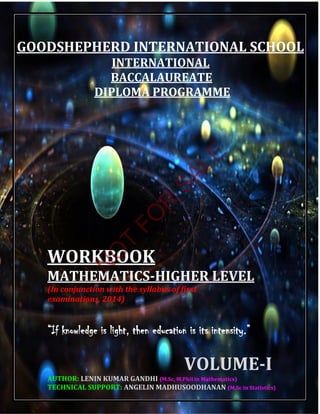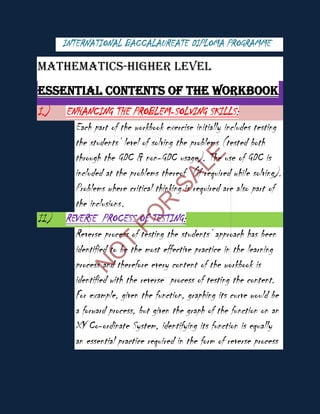This document provides an overview and introduction to an International Baccalaureate Diploma Programme Mathematics Higher Level workbook created by Goodshepherd International School. The workbook is designed to prepare students for IBDP Math HL examinations in 2014 and focuses on building problem-solving skills, testing reverse processes, connecting topics to real-life applications and history, and exploring concepts in different ways. It covers topics like circular functions, trigonometry, and binomial theorem through exercises that apply different command terms to thoroughly practice various approaches.























![TOPIC : SEQUENCE AND
SERIES
ARITHMETIC SEQUENCE (or ARITHMETIC PROGRESSION)
𝑎 − 𝑑, 𝑎, 𝑎 + 𝑑 , … … … … … ….
𝑎, 𝑎 + 𝑑 , 𝑎 + 2𝑑 , 𝑎 + 3𝑑 ,………………..
𝑈 𝑛 = 𝑢1 + (𝑛 − 1)𝑑
𝑆 𝑛 =
𝑛
2
(𝑢1 + 𝑢 𝑛) 𝑜𝑟
𝑆 𝑛 =
𝑛
2
[2𝑢1 + (𝑛 − 1)𝑑]
GEOMETRIC SEQUENCE ( GEOMETRIC PROGRESSION)
𝑎, 𝑎𝑟 , 𝑎𝑟2
, …………
𝑎
𝑟
, 𝑎 , 𝑎𝑟 , … … … … … … …
𝑈 𝑛 = 𝑢1 𝑟 𝑛−1
𝑆 𝑛 =
𝑢1(1 − 𝑟 𝑛)
1 − 𝑟
𝑜𝑟
𝑢1(𝑟 𝑛
− 1)
𝑟 − 1
, 𝑟 ≠ 1
𝑆∞ =
𝑢1
1−𝑟
if−1 < 𝑟 < 1.
𝐴 = 𝑃 (1 +
𝑅
100
)
𝑁
R – rate of interest
P- Initial amount
N- Time periods
Page 162 of 198.
IBDP Mathematics-Higher LevelWorkbook .
.
N
O
T
FO
R
SALE](https://image.slidesharecdn.com/696aa3b5-9e53-4f58-b0ea-938677a5ac7b-151218103850/85/Math_HL-Workbook_Water-Marked-24-320.jpg)







































